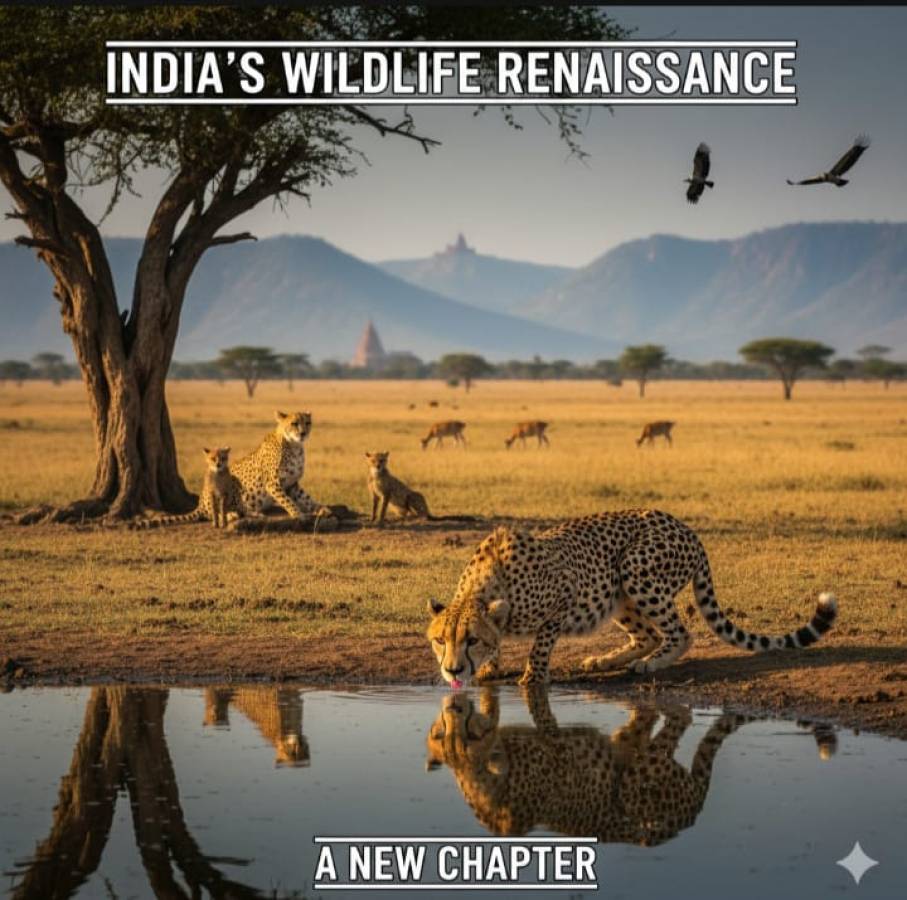
India’s wildlife is at a crossroads, teetering between spectacular conservation successes and looming ecological crises. Home to 7-8% of the world's recorded species, the country shelters Bengal tigers, Asiatic lions, elephants, snow leopards, and a vast array of flora and fauna across its 106 national parks and 567 wildlife sanctuaries. Project Tiger, the Asiatic lion’s revival in Gir, and elephant conservation efforts are hailed as global success stories. Yet, beneath these triumphs lie critical concerns—shrinking habitats, increasing human-wildlife conflicts, illegal poaching, and climate change-induced disruptions. In 2023 alone, 142 tigers died, and over 600 sea turtles washed up dead on the eastern coast. Government funding for conservation has been slashed, and encroachment threatens vital corridors. As India strides toward rapid urbanization, the battle for coexistence intensifies. Can the nation balance its economic aspirations with preserving its rich biodiversity, or are we staring at an irreversible loss of our natural heritage?
Tiger Conservation: A Double-Edged Sword
India's tiger conservation journey is both a beacon of hope and a cautionary tale. From a perilous low of 1,411 tigers in 2006, their population rebounded to 3,682 by 2023, making up nearly 75% of the world’s wild tiger population. This success stems largely from Project Tiger, launched in 1973, now overseeing 57 tiger reserves nationwide. However, cracks have begun to show. Between 2018 and 2023, government funding for Project Tiger was slashed from ₹322.9 crore to ₹150.6 crore. Meanwhile, tiger mortality rates have surged, with 142 deaths recorded by September 2023 alone. Alarmingly, over half of these fatalities occurred outside protected reserves, raising urgent concerns about habitat fragmentation and human encroachment. Conservationists warn that without sustained investment in habitat protection and expansion, India’s tigers might once again face peril despite the numerical gains.
Asiatic Lions: Guardians of Gir
The Asiatic lion, once on the brink of extinction, now thrives in Gujarat’s Gir Forest. From a mere 20 individuals in the early 20th century, their numbers have risen to over 674 as of 2020. This revival owes much to the harmonious coexistence between local communities and these majestic predators. However, Gir’s success has bred new challenges. The lions’ rising population has led to territorial expansions beyond the protected forest, increasing human-lion encounters. Additionally, conservationists warn of genetic bottlenecks, as the entire population remains confined to a single region. Efforts to relocate some lions to Kuno National Park in Madhya Pradesh have faced bureaucratic hurdles, political opposition, and logistical delays. If alternative habitats are not secured soon, the species could face new threats despite its recent resurgence.
Elephants: Navigating Modern Challenges
India’s elephant population, estimated at around 27,000, faces mounting threats. Habitat fragmentation, exacerbated by invasive species like Lantana camara—introduced during British rule—has severely degraded traditional elephant corridors. As a result, elephants increasingly venture into human settlements in search of food, leading to deadly confrontations. Between 2019 and 2023, elephants were responsible for 2,829 human fatalities, with Assam alone reporting 629 deaths in 2022. In response, the Indian government has deployed technological solutions like the "Haati App," which alerts villagers of approaching elephants to prevent conflicts. However, conservationists argue that unless large-scale habitat restoration and wildlife corridors are prioritized, these measures will offer only temporary relief to a growing crisis.
Sea Turtles: A Race Against Time
India’s eastern coastline has become a graveyard for sea turtles, particularly around Chennai, where over 600 dead turtles were reported in a single month in early 2024. The primary culprit? Accidental entrapment in fishing nets. Overfishing, rising sea temperatures, and increasing operational costs have driven fishers closer to shore, intensifying threats to olive ridley turtles. In response, authorities have been advocating for turtle excluder devices in fishing nets, stricter monitoring, and community-led conservation initiatives. However, these efforts remain hamstrung by enforcement challenges and economic pressures on coastal communities. Unless sustainable solutions are implemented, one of the world's most critical nesting sites for sea turtles may soon face irreversible damage.
Protected Areas: Sanctuaries Under Strain
India currently boasts 106 national parks and 567 wildlife sanctuaries, covering approximately 5.28% of its geographical area. While these reserves serve as biodiversity hotspots, they often exist as isolated islands amid rapidly expanding human settlements. The need for well-connected wildlife corridors has never been more urgent. Take the Western Ghats, a UNESCO World Heritage site, which harbors over 325 globally threatened species, including the Nilgiri tahr and lion-tailed macaque. Deforestation, illegal mining, and infrastructure projects continue to threaten this biodiversity haven. Conservationists are calling for stricter environmental regulations and sustainable development models that balance human needs with ecological preservation.
Community Engagement: The Linchpin of Conservation
India’s conservation success stories owe much to local and indigenous communities. Their traditional knowledge, when combined with modern conservation science, has led to groundbreaking initiatives. In many tiger reserves, community-led ecotourism has emerged as a viable alternative livelihood, reducing dependence on forest resources while fostering conservation stewardship. Such models highlight the importance of involving local populations in decision-making processes, ensuring that conservation efforts are both effective and inclusive.
International Collaborations: A Unified Front
In April 2023, India launched the International Big Cat Alliance (IBCA), an ambitious global initiative focused on conserving the world's seven principal big cats: tigers, lions, snow leopards, leopards, jaguars, pumas, and cheetahs. With 97 member countries, the alliance seeks to strengthen anti-poaching measures, share best practices, and foster international collaboration. India’s commitment of $100 million over five years underscores its leadership role in global big cat conservation. Yet, for these efforts to be meaningful, they must be accompanied by rigorous on-ground implementation and sustained governmental support.
The Road Ahead: Challenges and Opportunities
While India’s conservation achievements are commendable, the challenges ahead are formidable. Climate change poses unpredictable threats to ecosystems and wildlife. Human-wildlife conflicts, if left unchecked, could erode public support for conservation. Additionally, the balancing act between infrastructure expansion and ecological preservation remains fraught with contention. However, India has proven that with political will, community participation, and scientific rigor, conservation miracles are possible. The coming years will test whether the nation can sustain its hard-won gains or if economic ambitions will overshadow its natural legacy. The answer to this question will shape the future of India’s wildlife for generations to come.





















